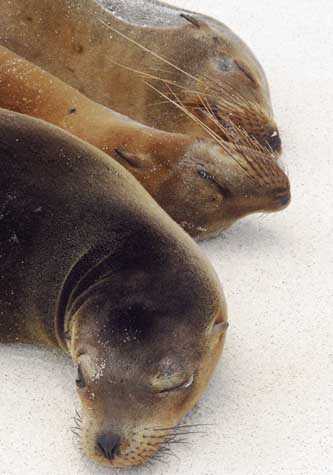Early in the morning, we arrived at Espanola Island for our first full day in the Enchanted Islands. From the distance and in the garua (the local term for a fine mist), the island looked rather mysterious. The sea was calm and our kayaks were lowered for a first exploration alongside the rocky shore. Espanola is the oldest of the Galápagos Islands, and it is the home to various species that are unique to this particular island. One of them is the Espanola mockingbird, an inquisitive bird that seems to prefer to walk or run on the ground instead of flying.
We had a busy morning. Some guests chose to explore the underwater world and made the journey to adjacent Gardner Islet, with its blue waters and playful sea lions. Several species of fish were to be found there, like the king angel fish, razor surgeonfish, and sergeant majors. After this magnificent experience we had a chance to visit the beautiful white-sand beach of Gardner Bay. The sighting of dozens and dozens of Galápagos sea lions lying on the beach was overwhelming! Some were sleeping, but many were up to something: wrestling, bodysurfing, courting, nursing. Just observing them was fun from beginning to end. Weather-wise, it was a typical cool season day, changing between fine mist and sunny spells.
All this activity made us extremely hungry, and lunch today was a special one. The menu of the day was a typical Ecuadorian lunch. What a feast! Dishes from various regions of Ecuador were represented in a wonderful buffet, and after a typical lunch followed a typical Ecuadorian siesta.
A nap was certainly a good idea, as next in our program was a walk along the rocky trail of Punta Suarez. This is a point in the western tip of the island that is full of life. Right by the landing area were large numbers of marine iguanas. The local iguanas show a red coloration on their backs, a trait only present in the populations of Espanola and Floreana. The day had been a little cold so by the time we arrived the iguanas were piling up in order to absorb body heat more efficiently. As we continued along the trail, we had to find a way around some sleeping Galápagos sea lions, something that occurs quite often here! The lava lizards of Espanola are also endemic, and are much larger and more colorful than anywhere else in the archipelago.
Further along the coast, we could see that many seabirds had colonized this area, including the endemic Nazca boobies. Another seabird species found here is the emblematic blue-footed booby, and we were extremely happy to see many couples courting, hopefully to successfully contribute to the population. But our hopes this afternoon were to see the famous waved albatross, which we did! This endemic species has chosen Espanola as its home due to its topography and location. Espanola has tall cliffs from which the birds can easily take off, and it is surrounded by a vast, nutrient-rich ocean. We walked through the albatross territories where many of them courted, danced, and called to each other, a charming ritual that ensures fidelity between couples. Their fluffy little brown chicks were already growing, and we strongly hope that they will be ready by the end of the year when the adult population abandons the island and migrates south temporarily. With pink and yellow colors of the setting sun bathing us, we experienced the magic of Galápagos on full display!







